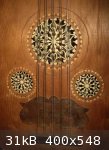
koma - 2-7-2012 at 01:24 PM
Hi all, I have been following this site for long. thanks to all advices I get here!
this is my first question:
can anyone identify this oud? it has no label and this is how it looks. thank you again
Sam



Brian Prunka - 2-7-2012 at 01:37 PM
Sorry, it doesn't look familiar to me. It looks like a fairly old oud, probably from Syria or possibly Lebanon.
koma - 2-8-2012 at 09:10 AM
thanks Brian, I am wondering if the frets were added later...
one of the weird affinities on this oud is the distance between the rosette & qamariyyat and the fingerboard...
I'll keep looking
Amos - 2-8-2012 at 11:00 AM
I agree with Brian, it looks Sryian to me...you couldn't possibly get a picture of the label could you? (if there is one...)
jdowning - 2-9-2012 at 11:52 AM
I am curious about this oud as well as. Some features about it that strike me as being unusual are:
- the main rosette seems to be positioned proportionally too low on the sound board.
- the neck is short (less than one third of string length).
- there are tied frets on the neck.
- all the strings of the five double courses seem to be of equal diameter?
- the strings are not tied over the bridge but are knotted behind the bridge.
- the sound board grain is quite coarse and crooked.
The neck could have been shortened (there is a white spacer at the neck joint) - or it may have been designed to accommodate only 5 or 6 frets?
Is the oud functional as an instrument or could it be just a decorative piece - made for the late19th C tourist trade perhaps?
Are the above features typical of a Syrian or Lebanese oud - or could it be from Egypt or one of the North African coastal regions?
A side view of the oud would be of interest as well as the string length.
jdowning - 3-9-2012 at 08:15 AM
Ronnie Andersson has notified me of the location of this oud. It is for sale here advertised with some additional images:
http://www.pamelasmusic.co.uk/images/Forsale/string/mandolins/L099....
The oud was once in the possession of the late Arnold Dolmetsch - pioneer of the early music movement in England - which explains the tied frets as it
was no doubt once used as a substitute for a lute. So in this respect the oud has some historical value and interest although there is no further
information on its origins - unless this can be found recorded in papers left by A. Dolmetsch presumably still in the hands of the Dolmetsch
family.
